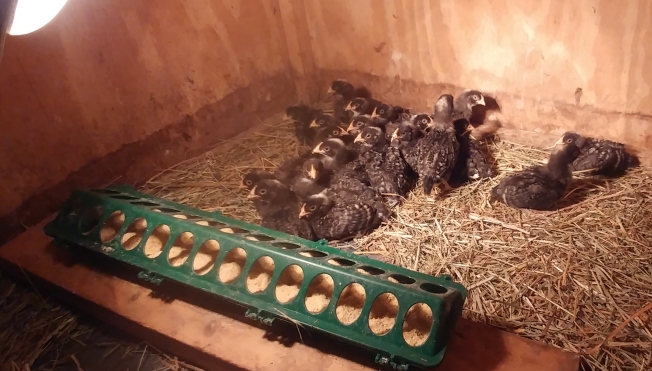Chickens don’t have to be expensive!
Unfortunately, it took us many years to learn this lesson. When we first moved to the country, we routinely ordered batches of baby birds directly from the hatchery. There are several good suppliers out there, and their catalogs (now websites) are fun to browse. We were able to try out various breeds, and arrange for delivery on specific dates all the way into August or September. If there’s a very particular, obscure poultry breed that you’d like to try out, a special order from a hatchery may be the only way to go. And the highly reputable hatcheries, like Murray McMurray, would even provide a refund if any birds arrived dead or died within a certain number of days of arrival.
The hatchery route isn’t a bad way to go, but it can get pricey. Do you want 25 pullet chicks from a good egg laying breed like Barred Rock? At McMurray, those will cost you $2.89 each, plus shipping. From the hatchery nearest us (a couple of hours away), the price is $2.75 each for a box of 25. Then add $15 for shipping. If you want a smaller order, you’ll pay significantly more per bird.
Each spring, our local feed store / grain elevator puts together a large group buy from that hatchery, with orders arriving on specific days. That saves on shipping, and the price per bird is a little less.
Also in the spring, for several weeks the big farm stores like Tractor Supply will put out large tubs with baby chicks and other poultry, under heat lamps. It’s actually a lot of fun to visit the stores during “chick days,” and to be able to browse all the various birds that are available. You can mix and match whatever you want, and there’s no shipping. Prices are similar to what you’d pay from the hatchery ($2.99 for a Barred Rock pullet chick, for example). The downside is, you’re limited to what they have on hand. If you want something unusual, you’re out of luck.

When we first started doing this, we were big on trying unusual and different breeds of birds. Over time, we came to settle on some favorites — which, fortunately, are the favorites of a lot of other people … which means they are widely available. When it comes to layers, we like Barred Rocks and Buff Orpingtons, but aren’t averse to New Hampshire Reds, Rhode Island Reds, and some of the others like ISA Browns. During spring chick days, farm stores have plenty of birds from these common and popular breeds.
Hens are reliable layers for about two years; after that, their egg production slows — so, we like to butcher our hens in the fall of their second year. How do you know how old a hen is? It’s tough to tell by looking. We solved this problem by getting a very different looking breed each year. In 2015, we had Barred Rocks. We butchered them last fall. In 2016, we got Buff Orpingtons. They’re still going strong. In fact, we got too many, so we didn’t get pullet chicks last year. We will butcher them this fall.
So, as you might guess, it’s now a Barred Rock year. We need about twenty to provide the eggs our family needs. However, given how long the cold weather had been lingering in Michigan this “Spring,” I’d been holding off on actually buying the chicks. Cold and rainy weather means the babies need to be brooded under heat lamps for a longer time, until they’re fully feathered and strong enough to withstand the elements.
With the arrival of nicer weather, I’d begun browsing the local farm supply stores. Yesterday, I hit the jackpot: Family Farm & Home in Mason had a large tub of “senior” Barred Rock pullet chicks, marked down to just one dollar each. They were mostly feathered, and the sales clerk estimated them to be about a week and a half old. That means we’ll only need to keep them in the brooder over the weekend, and we’ll be able to get them out into a pasture pen on Monday.
I bought twenty. And, lest you fear that the store was losing money on me … while I was there, I also bought a new chick feeder and a new waterer (our old ones had definitely seen better days).

Getting chicks this way is hit or miss, but when you get a hit … the payoff is big. This score is right up there with last fall’s post-Halloween pumpkins, (though not quite as good a deal as the absolutely free December 26th Walmart Christmas trees.) Not only did I save around $40 compared to full retail, but I also saved the cost of running a 250 watt heat lamp around the clock for about ten days. Plus the cost of feeding the chicks a high protein ration for about ten days. We also saved ourselves ten days’ worth of the hassle of checking on the brooder a few times a day. Not to mention the fact that chicks are most fragile, and therefore most likely to die, in their first days of life. The twenty I got yesterday are well established and have proven themselves strong.
Here’s looking forward to lots of wonderful eggs in the fall, at a price that can’t be beat!

Pingback: Chicken Graduation Day | The Yeoman Farmer